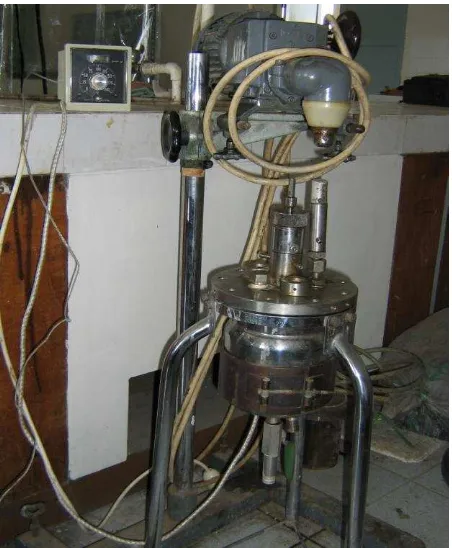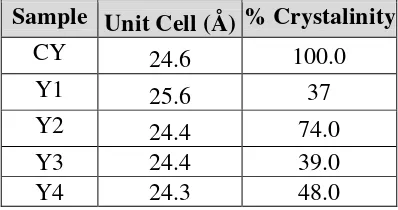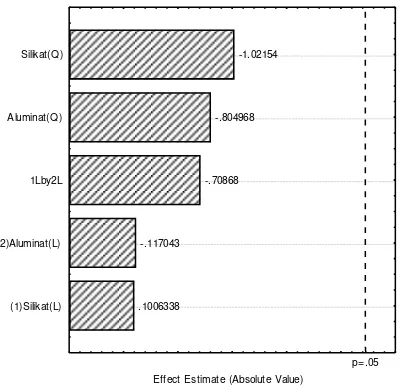THE OPTIMATION OF PRODUCTION ZEOLITE
SYNTHESIS Y FROM RICE HUSK ASH
Didi Dwi Anggoro
a, Ojo Kurdi
b, Kasmui
caDepartment of Chemical Engineering,University of Diponegoro, Semarang, Indonesia bDepartment of Mechanical Engineering,University of Diponegoro, Semarang, Indonesia
cDepartment of Chemistry, UNNES, Semarang, Indonesia Corresponding author’s email address: [email protected]
ABSTRACT
Rice husk is the milling byproduct of rice and is a major waste product of the agriculture industry. Amorphous silica, commonly referred to as rice husk ash, was extracted from rice husk by acid leaching, pyrolysis, and carbon-removing processes. On the other hand, the pure silica with a high specific surface area, high melting point and high porosity can be obtained from rice husks. These properties make the ash a valuable raw material for many industries. This paper is study of synthesized of zeolite Y from rice husk ash. Zeolite Y synthesis is used for petroleum industry as expensive catalyst. Rice husk was calcined at temperature 700oC for two hours using furnace to produce pure silica . The composition of synthesized
of zeolite Y from rice husk was 2.24 Na2O : Al2O3 : 8 SiO2 : 112 H2O.The gel solutionwas mixed at room
temperature for 24 hours using autoclave. Then, the gel solution was heated with variable temperature and time crystallization. The product zeolite synthesis Y was filtered and washed with distilled water until pH lower than ten, than dried at oven. This product was analyzed with X-Ray Diffraction (XRD). From
XRD analyze result indicated that from rice husk ash can produced zeolite synthesis Y which high structure and crystallization degree. The optimum condition for synthesized zeolite Y from rice husk ash was temperature 100oC for 48 hours.
Keyword: Optimization, Rice Husk Ash, Synthesized, Zeolite Y
1.
INTRODUCTION
The present world rice production of about 400 million tons per year will probably increase in the future, owing to the great increase in population, particularly in Asian countries. When rice grains are husked, the husks make up about 14 to 35%, depending on the variety of rice; since the husks have a low bulk weight of about 100
kg/m3, they take up 560 to 1400 million m3. In Indonesia, rice husk ash is produced in abundance after every
rice harvesting reason [1].
Chemical analysis of rice husks shows the following typical composition [2]:
Water : 9.0 %
Silica is the major constituent of rice husk. The composition of the mineral ash is normally within the following limits [2]:
In addition, up to 30% carbon is found, depending on the degree and nature of combustion of the organic constituents before analysis. Because of its non biodegradable property, the presence of the silica ash causes a number of problems to the environment. In order to solve this problem, useful applications of the waste product are desirable.
This paper is study of synthesized of zeolite Y from rice husk ash. Zeolite Y synthesis is used for
petroleum industry as expensive catalyst [5-9]. Rice husk was calcined at temperature 700oC for two hours using
furnace to produce pure silica.
2.
EXPERIMENTAL
The raw material rice husk was obtained from a rice mill. Their major constituents are cellulose, lignin and ash. Amorphous silica, commonly referred to as rice husk ash (RHA), was extracted and purified from rice husk by acid leaching, pyrolysis, and carbon-removing processes. In this experiment, the raw rice husk was
washed with distilled water to remove adhering soil and was then dried at 100oC in an air oven. The dried rice
husk was refluxed with 3N HCl solution in a glass round-bottomed flask at 100oC within a thermostat for 1 h.
After leaching, the husk was thoroughly washed with distilled water and dried.
The composition of synthesized of zeolite Y from rice husk was 2.24 Na2O : Al2O3 : 8 SiO2 : 112 H2O.
The gel solutionwas mixed at room temperature for 24 hours using autoclave, as shown Figure 1. Then, the gel
solution was heated with variable temperature and time crystallization. The product zeolite synthesis Y was filtered and washed with distilled water until pH lower than ten, than dried at oven. This product was analyzed
with X-Ray Diffraction (XRD).
Figure 1. Stainless steel Autoclave with stirred
3.
RESULTS and DISCUSSION
3.1. Effect of Time
X-ray diffractogram of commercial zeolite Y (CY) and synthesis zeolite Y (Y1, Y2, and Y3) is shown in
Figure 2. It indicates that all samples have zeolite Y crystal, but have different crystallity percent. Percent of crystallinity and unit cell are calculated by following equation [7]:
Intensity of peak (sample)
Crystallinity (%) = x 100% Intensity of peak (standard)
Figure 2. X-Ray Diffractogram of Four Samples
Crystallization of all synthesis zeolite Y is lower than commercial zeolite Y, as tabulated in Table 1. The different behavior shown between the silica RHA and the commercial silica is attributed again to the form of silicate aniouns in the initial mixture. The crystallization of zeolite starts from the liquid phase that leads to the crystallization of zeolite Y depends on the silica source. In both cases, the different solubilities of the silicate anions and the resulting interaction with the aluminate anions presence in the solution contribute to the different behaviour of both types of silica [7].
Table 1. Unit Cell and Percent of Four Samples
Sample Unit Cell (Å) % Crystalinity
CY
24.6
100.0
Y1
25.6
37
Y2
24.4
74.0
Y3
24.4
39.0
Y4
24.3
48.0
3.2. Effect of Temperature
X-ray diffractogram of commercial zeolite Y (CY) and synthesis zeolite Y (Y2, and Y4) is shown in
Figure 2. It indicates that all samples have zeolite Y crystal, but have different crystallity percent. Crystallization of all synthesis zeolite Y is lower than commercial zeolite Y, as tabulated in Table 1. The different behavior shown between the silica RHA and the commercial silica is attributed again to the form of silicate aniouns in the initial mixture.
Zeolit Y komersial (CY)
100oC_ 24 jam (Y1)
100oC_ 48 jam (Y2)
100oC_ 144 jam (Y3)
3.3. Effect of Silicate and Aluminate
The optimum condition (100oC and 24 hours), which obtained in first and second experiments, is used to
estimed the effect of silicate and aluminate. For this purpose, the experiment design and resuts is tabulated in Table 2.
Table 2. The experiment design and results with difference temperature, silicate, and aluminate
Run Temperature (oC) Si Al Kristalinitas (%)
From Table 2, the effect temperature and silicate on zeolite Y synthesis can be obtained by pareto chart analysis, as shown Figure 3. Figure 3 indicated that the temperature has more effect than silicate. The optimum condition between temperature and silicate for zeolite Y synthesis can obtained by 3D analysis using statistica 2002 software, as shown Figure 4. Figure 4 indicated that the optimum conditions for synthesis zeolite Y are the
temperature at 100oC and silicate at 20%.
.1301391
From Table 2, the effect temperature and aluminate on zeolite Y synthesis can be obtained by pareto chart analysis, as shown figure 5. Figure 5 indicated that the temperature has more effect than aluminate. The optimum condition between temperature and aluminate for zeolite Y synthesis can obtained by 3D analysis using statistica 2002 software, as shown Figure 6. Figure 6 indicated that the optimum condition for synthesis
zeolite Y are the temperature at 100oC and aluminate at 10%.
-.144364
Figure 5. Pareto chart analysis for temperature and aluminate
From Table 2, the effect silicate and aluminate on zeolite Y synthesis can be obtained by pareto chart analysis, as shown Figure 7. Figure 7 indicated that the crystalinity of zeolite Y synthesis not depend on both silicate and aluminate. The optimum condition between silicate and aluminate for zeolite Y synthesis can obtained by 3D analysis using statistica 2002 software, as shown Figure 8. Figure 8 indicated that the optimum condition for synthesis zeolite Y are the silicate at 20% and aluminate at 10%.
4.
CONCLUSIONS
From the experimental result for synthesis zeolite Y using rice husk ash, characterization analyis using X-Ray Diffraction (XRD), and optimasi analysis using statistica 2002 software can conclude that:
1. Rice Husk Ash is potential silica sources for produce synthesis zeolit Y.
2. Temperature and time of synthesis are not affected of unit cells length, but affected of percent of
cryatallinity.
3. Temperature at 100oC and time at 48 hours are the best operation condition of synthesis zeolite Y, because
the high percent crystallinity is obtained.
4. The optimum condition for synthesis of zeolite Y from rice husk ash are temperature at 100oC, silicate at
20%, and aluminate at 10%.
ACKNOWLEDGMENTS
The authors express their gratitude to the Higher Education of Indonesian Education Ministry for financial support of this research by DIPA Project, No SP: 014/SP2H/PP/DP2M/III/2007.
REFFERENCES
[1] Biro Pusat Satatistik (2002). Laporan tahunan Industri Indonesia.
[2] Tutsek, et al. (1977), “Method of producing low-carbon, white husk ash”, United States Patent 4,049,464 September 20, 1977.
[3] Vaughan, et al. (1979), “Synthesis of type Y zeolite”, United States Patent 4,178,352 December 11, 1979.
[4] Kostinko, et al. (1981), “Method of Producing ZeoliteY”, United States Patent 4,264,562 (April 28, 1981).
[5] Halimaton Hamdan (1996). Si MAS NMR, XRD and FESEM Studies of Rice Husk Silica For The Synthesis of Zeolites. Journal of Non-Crystalline Solids,Elsevier.
[6] Ming - Tseh Tsay and Feg - Wen Chang, (2000), “Characterization of rice husk ash-supported nickel catalysts prepared by ion
exchange”, Applied Catalysis A: General 203, pp. 15–22.
[7] Szostak, R. (1989). Molecular Sieves Principles of Synthesis and identification. Van Nostrand Reinhold Catalysis Series. Elsevier.
[8] Twigg, Martin V, (1996). “Catalyst HandBook“, second edition, Manson Publishing Ltd, London, pp. 267.
[9] Zainab Ramli, Listiorini E., Hamdan H. (1996). Optimization and Reactivity Study of Silica In The Synthesis of Zeolites From Rice Husk. Jurnal Teknologi, bil.25, Universiti Teknologi Malaysia.
[10] Didi Dwi Anggoro, Ojo Kurdi, Kasmui. (2006). Optimasi Pembuatan Zeolit Sintesis Y dari Abu Sekam Padi, Proseding Seminar Nasional Teknik Kimia Indonesia, 19-20 Juli 2006, Universitas Sriwijaya, Palembang.
[11] Didi Dwi Anggoro, Ojo Kurdi, Kasmui. (2006). The Utilization of Rice Husk Ash for Producing of Zeolite Synthesis Y, Proceeding of Second International Conference on Environment and Urban Management, 2-3 August 2006, Soegijapranata Catholic University, Semarang.
[12] Glusker, J.P and Trueblood, K.N (1972). “Crystal Structure Analysis: A Primer”. New York, Oxford University Press.
[13] Houston, D. F, (1972), “Rice, Chemistry and Technology”, Vol IV, American Association of Cereal Chemist Inc, St Paul, Minnecota, pp. 245.
[14] McKetta, J. (1981). “Encyclopedia of Chemical Processing and Design”, Chapter 13: Cracking, Catalytic to Crystallization, Marcel
Dekker Inc., New York. pp. 546.
[15] Nor Aishah Saidina Amin and Didi Dwi Anggoro, (2004). “Optimization Of Direct Conversion Of Methane To Liquid Fuels Over Cu Loaded W/ZSM-5 Catalyst”, Fuel, Elsevier Ltd. Vol. 83, pp. 487-494.
[16] Scherzer J. (1990) Octane – Enhancing Zeolitic FCC Catalysis. Marcel Dekker.Inc. pp. 356.
[17] Seleng T, (1994), “Penelitian Pemanfaatan abu Sekam Padi sebagai Penukar Ion Pada Daur Ulang Air Limbah Industri Logam”, Majalah Komunikasi, pp. 34.



